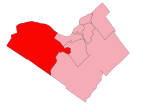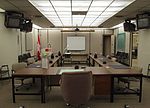Dunrobin/Parti Field Aerodrome
Ontario airport stubsRegistered aerodromes in Ontario
Dunrobin/Parti Field Aerodrome (TC LID: CPF3) is located 2.1 nautical miles (3.9 km; 2.4 mi) west northwest of Dunrobin, Ontario, Canada.
Excerpt from the Wikipedia article Dunrobin/Parti Field Aerodrome (License: CC BY-SA 3.0, Authors).Dunrobin/Parti Field Aerodrome
Vances Side Road, Ottawa
Geographical coordinates (GPS) Address External links Nearby Places Show on map
Geographical coordinates (GPS)
| Latitude | Longitude |
|---|---|
| N 45.426944444444 ° | E -76.067777777778 ° |
Address
Dunrobin Parti Field Airport
Vances Side Road
K0A 1T0 Ottawa (West Carleton-March)
Ontario, Canada
Open on Google Maps





